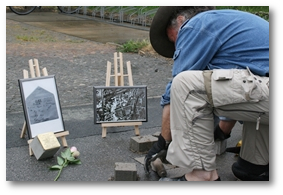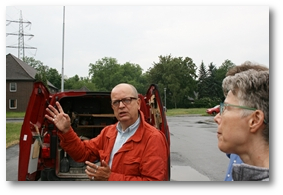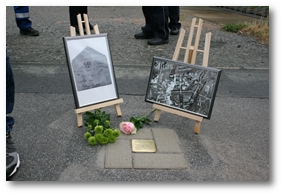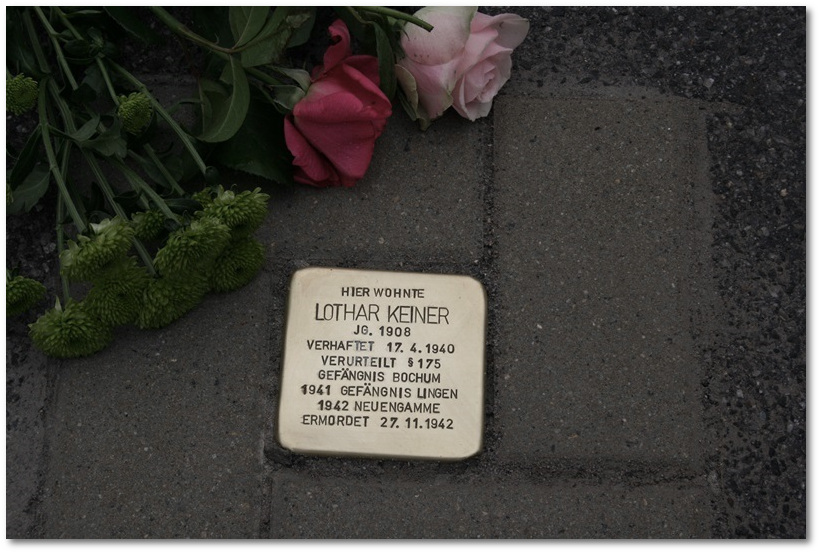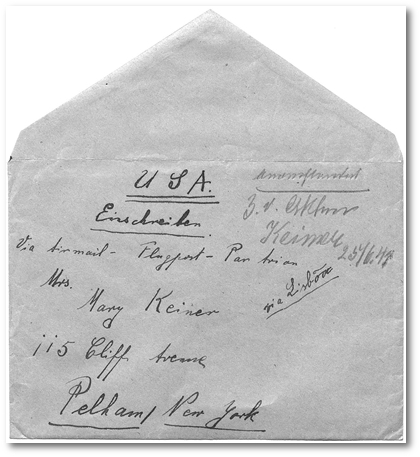 Fig. 1: This envelope was handwritten by Lothar Keiner and was supposed to be sent to his mother Mary Keiner who lived in the States. The envelope was found in his criminal file and never reached the addressee. Fig. 1: This envelope was handwritten by Lothar Keiner and was supposed to be sent to his mother Mary Keiner who lived in the States. The envelope was found in his criminal file and never reached the addressee.
Who was Lothar Keiner? Short Survey
Lothar Adolf Wilhelm Keiner, born in Mannheim on 18th Aug., 1908, last address by choice: Helenenstrasse 13 in Gelsenkirchen-Horst, last occupation as an installation worker, arrested in April 1940 by the (Gelsenkirchen)-Buer detective police on the grounds of homosexual contacts, no previous convictions, sentenced according to §175 on 15th June, 1940 by the District Court , Essen to 2 years in prison, imprisonment in Bochum (Krümmede) and in Lingen/Emsland. After Lothar Keiner had finally served the sentence, the police of Recklinghausen took him in „preventive detention“ and in April 1942 he was deported to the concentration camp Neuengamme near Hamburg. There he was murdered on 27th November, 1942, the alleged cause of death was recorded as „circulatory collapse and heart failure resulting from intestinal catarrh (diarrhoea).
What do we know about him?
Lothar A.W Keiner was born in Mannheim, Wespinstrasse 4 on 18th August, 1908. His brother Oswald Eduard Keiner was also born there on 10th January, 1910 (deceased in the meantime, presumably in the United States). Their parents were the company lawyer, i.e. Syndicus Dr. Oswald Ehrenfried Keiner, economist in the ministry of economics in Stuttgart (born in Schweinschied near Meisenheim on 08th July, 1879 and died in Essen on 01st June, 1935) and Marie Keiner (Mary Keiner) née Jaiser (born in Stuttgart on 04th October, 1882, date of death unknown, presumably in the United States).
The marriage of the parents was contracted on 15th November, 1906 in Stuttgart, the city which became their new home town, when they moved from Mannheim in 1915. Father O.E. Keiner was a soldier in the German army in World War I.The records referring to the divorce case describe“ the marriage as not extremely happy from the beginning“. During the divorce proceedings the still-married couple accused each other of extramarital affairs, they reported of a first step towards a separation, but they still shared the same appartment - with separate households. Thus the two kids inevitably got involved in the marital conflict of their parents. Both reported of several attempts of reconciliation, which in the end led to nothing but a separation. Both parties were found guilty of the failure of marriage.
21 years later Lothar Keiner declared in a trial against him accusing him of homosexual contacts at the District Court of Essen, that „ he was still suffering from the aftermaths of an unhappy childhood
After the divorce of his parents Lothar Keiner passed his o- level at the Realgymnasium (secondary school focussing on natural sciences and mathematics) in 1925. Regarding his further career he reports that he did not decide on any apprenticeship but worked as a stenographer for the Essener Allgemeine Zeitung (daily newspaper of the city of Essen) until 1927. After that, he worked on a farm, from 1929 to 1935 he lived in the United States, then he went back to Germany and earned his living in the hotel and building industry, from 1939 onwards he worked for the Hochdruck-Rohrleitungs GmbH (a pipeline construction company in Gelsenkirchen). He lost his job there on 17th April, 1940 when he was dismissed as a result of his imprisonment based on the approach of homosexual contacts.
All records handed down from the year 1940/41 describe Lothar Keiner as follows: He was 1,80 m tall, slenderly built, approx. 72 kg, oval face, dark blonde, brown eyes, small mouth, false teeth upper jaw, second toe missing on left foot. No previous convictions. Besides German language skills in English, French and Italian ( the command of which enabled him to exchange letters from prison with a priest living in the Italian town of Ripatransone in Italian - with considerable mistakes,though). Letters passed down obiously written in prison and addressed to his mother who lived in the United States, also those written to a friend of the parents in Dortmnd, and the ones written to the Italian priest, clearly show that he was a man interested in politics and who was sufficiently informed what was going on. He definitely knew numerous places and countries by travelling. He was of protestant belief and religious, an avid reader and was eager to educate himself.
His mother and her two boys Oswald Eduard Keiner and Lothar moved to the States towards the end of the twenties, but in 1935 Oswald and Lothar came back to Germany, temporarily living together with the new family of their father, who had married again in 1928. His second wife was Gertrud Keiner, née Wimmer, born in Gladbeck on 24th April, 1902. This meant that the second wife of father Keiner was only 6 years senior to his son Lothar. Two children resulted from this second marriage: Heinrich Keiner (born in Essen in 1929, married in Essen in 1955) and Waltraud Keiner (born in Essen in 1932, married in Essen 1957, now: Waltraud Bögel, called Stratmann). Besides his brother, Lothar thus had a half brother and a half sister, who were both considerably younger.
His father Oswald Ehrenfried Keiner died on 01st June, 1935 in Essen, possibly a severe disease of the father was the reason why the two sons returned to Essen. After he had died, his son Oswald went back to his mother in the States. Lothar left Essen and moved to Hamburg, but in 1936 he went back to Essen and for a couple of weeks he lived in the household of the second wife of his father. After that, he moved to Gütersloh, and in August 1939 he rented a ready-furnished room as a subtenant of the family H. in Gelsenkirchen where he had found work.
He often had the 16 year old son of family H. as a visitor in his room who sought his company, they spent their leisure time together, talking, playing cards, having parties with some friends as well as a co-worker of Lothar. All these teenagers were between 15 and 17 years old. They also celebrated New Year's Eve of 1939 together with 3 girls.
During that time it occured that Lothar K. and the son of his landlady had repeated sexual contacts.
In later interrogations Lothar was accused of sexual contacts with other male persons who were members of their clique, as well as with a co-worker, moreover there had been several futile attempts of molestation, as the persons in question had rebuffed the sexual approaches self-
consciously. In addition, documents relating to the sentence dated 15th June, 1940 pronounced by the district court of Essen reveal an attempt of molestation of a co-worker: „ The 17 year old witness Ha. was a colleague of the defendant.The witness Ha. refused the intention of the defendant and gave him a good thrashing instead.“
A short excursus
The National Socialists, being in power since 1933, cemented their racist and inhuman worldview into so-called „laws“ that they enacted : f.e. Starting from 1st September, 1935 they tightened §175 dating back to the German empire and Kaiser Wilhelm II. This paragraph penalizes homosexual men who have sexual contacts with other male partners in mutual consent. They extend and toughen up elements of crime, by the artificial construction and introduction of alleged offences ( even kisses, lascivious gazes and getting into contact can lead to interrogation and penalty, also for the first time homosexual prostitution is being prosecuted): they aggravate the range of punishment in context with §175 from jail to hard labour penalty facilities (Zuchthaus) up to 10 years. They spy on meeting points of the homosexuals, arrange police raids, list all homosexuals known by name, exert pressure by strict censorship, prohibit the print of magazines, and destroy clubs and associations. In addition, the open agitation in public and the biased press as well as the NS propaganda media (Röhmputsch) obviously fighting homosexuals create a climate of fear (angst) and intimidation among the population. The National Socialists are well aware of the lingering and more or less latent prejudice in general public, use it for their purposes and fuel resentments against gay men by marking them as subversive and as a threat to the state. Denunciations are part of this scenario. Squealers feel safe. §175 is also being used as a tool when prosecuting catholic clerics. The catholic church has become partly inconvenient and disturbing, so it has to be miscredited. As early as in 1934, the Gestapo founded a special department „homosexuality“; and in order to tighten measures they instal the „Reichszentrale zur Bekämpfung der Homosexualität und der Abtreibung“, i.e. a central administration combating homosexuality and abortions. The breeding of an „aryan“ race is the clear objective. Individuals that do not contribute to the consequent augmentation of population, need to be „eliminated“. After the 15th September,1935 the spiral of pursuit of jewish citizens is being turned further, when the „Nürnberger Rassegesetze“ were enacted.
|
The court regarded Lothar Keiner as the only guilty party – in strict accordance with the ideology of the National Socialists regarding homosexual persons. There was no investigation against the witness Ha. regarding bodily harm Although there was no mention of force or violence coming from Lothar Keiner (witnesses Ja. and H. were bewitched by his charm), the adolescences acted free-willingly and were not forced to anything, Lothar Keiner was sentenced to a drastical penalty of two years imprisonment. Keiner himself admitted his „guilt“. In excuse he explained “that he had no money for a brothel, so it occured to him that this would be a feasible solution. He had an unhappy childhood“. The court regarded his „guilty plea“ as positive, the more so as the defendant had no criminal record. As he showed penitence, severe penal servitude was renounced. By means of this „The Court of Justice wants to give the defendant the opportunity of sublimation and to abdicate the guilty pleasure in future. Should he lapse back into crime, though, he will have to experience the whole severity of law.“
As Lothar Keiner had „ admitted his guilt“, the pre-trial confinement starting from 18th April to 15th June, 1940 was set off against the penalty, so that in terms of figures, he should have been released on 18th April, 1942. But this did not happen. He served the sentence in full. At first, he was imprisoned in Bochum and was then transferred to the prison of Lingen/Emsland on 25th March, 1941. After having served the sentence for more than 50%, he made a mercy plea addressed to the Senior Public Prosecutor in Essen, who conferred with the prison chief of Lingen who answered on 01st Sept., 1941: „The technician Keiner serves a sentence of 2 years imprisonment until 18th April, 1942 because of perverted bawdiness. No previous conviction. Conduct and diligence good. Due to the severity of the act and the threat that he represents for all young males, we cannot approve an act of grace. He must experience the full force of law in order not to fall back into old patterns.“ At that time, the Himmler order of 1940 was in force and both, the prosecutor in Essen and the prison warden of the Lingen prison were very well aware of this order.
|
Heinrich Himmler, the head of the German police and at the same time head of the dreaded SS, a sub- division of the Nazi party, had decreed on 12th July, 1940 in a broadbush strategy:
„I demand to take any homosexual individual, who has seduced more than one partner,
into preventive detention on their release of jail.“
|
|
This decree of Himmler, one of the leading principals of the Nazi regime and a fanatic regarding the prosecution of homosexuals, lead to the immediate deportation of the condemned homophiles who had fully served their sentence, the very day they were released from prison. They never regained their freedom again but as a preventive prisoner they were sent to death. They died when they tried to flee or the SS simulated an escape, or by torture or gradual consumption due to malnutrition combined with catastrophic hygienic conditions and massive slave labour. All this was well known to both the prosecutor as well as the prison warden. They were well aware that by the refusal of the petition for mercy dated 8th September, 1941 they would most probably send him to death. And this is exactly what happened.
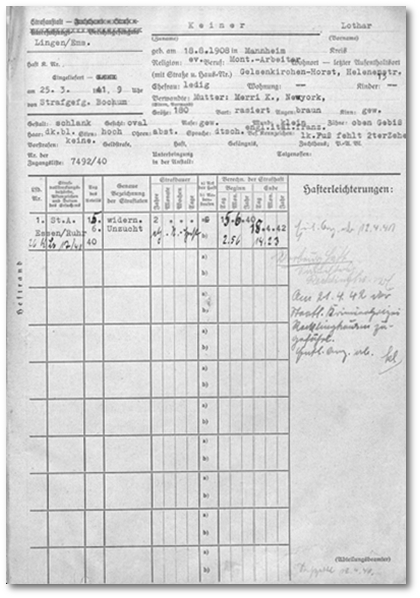 Fig. 2: document in the penal file of Lothar Keiner, kept at the prison of Lingen/Ems. Please click for magnification Fig. 2: document in the penal file of Lothar Keiner, kept at the prison of Lingen/Ems. Please click for magnification
After the refusal of his mercy petition Lothar Keiner fully served the sentence until 18th April, 1942. In order to make 100% sure that Keiner would not resume freedom after the end of his prison term, but will definitely be taken into preventive detention, the director of the prison of Lingen took the initiative to contact the criminal investigation department of Gelsenkirchen. He claimed as follows:
According to letters written by the installation worker Lothar Keiner he considered the United States as his homeland. He quotes Lothar Keiner word-by-word from one of his letters: „ I put my hand on the sword there and will abide to the flag until I will die.“ His mother lived in New York. Moreover, the prison director writes.“ This information note was written on the grounds that Keiner presents a serious danger for male adolescents although he was only sentenced to go to prison and although he has no criminal records.“
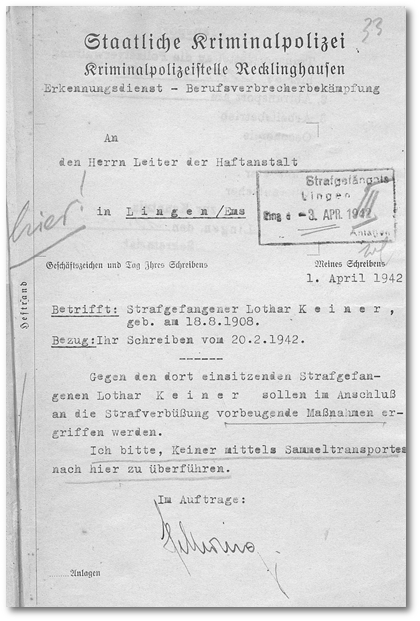 Fig. 3: document in the penal file of Lothar Keiner kept at the prison of Lingen/Ems. Please click for magnification Fig. 3: document in the penal file of Lothar Keiner kept at the prison of Lingen/Ems. Please click for magnification
The NS perpetrators in judiciary, penal system and police took their measures against Lothar Keiner. On 1st April, 1942 the Staatliche Kriminalpolizei, Kriminalpolizeiliche Stelle Recklinghausen, Abteilung Erkennungsdienst und Berufsverbrecherbekämpfung (the National Criminal Investigation Department, police station Recklinghausen, division police records department combiting professional criminals), informed the director of the Haftanstalt in Lingen (prison of Lingen):“ Against the convict Lothar Keiner preventive measures are to be taken. Immediately after his release prison inmate Lothar Keiner is to be transferred by consolidated transport to this address. And so it happened. The preventive detention initiated and practiced by the Kripo Recklinghausen starting from the 21st April, 1942 led shortly afterwards to the deportation to the concentration camp Neuengamme. There Lothar Keiner became No 7790, confinement category „BV“ (professional criminal).
Let us capture the facts: Only by reason of his sexual contacts to other male persons Keiner was sentenced to prison, subsequently without any new court decision to preventive decision followed by the deportation to the concentration camp Neuengamme, where he was registered as „BV =Berufsverbrecher) professional criminal. We do not know if he had to wear the „rosa Winkel“, the pink triangle as a sign for homosexuals, or the „grünen Winkel“, the green sign for dangerous criminals and murderers – in both cases a stigma clearly visible to all. Prisoners wearing the pink triangle were regarded as the lowest category of prisoners besides the Jewish concentration camp prisoners, which deteriorated their chance to survive considerably compared to other prisoners.
Often homosexuals would be registered in the concentration camps with the double abbreviation „BV175“. (which either did not happen in the case of Lothar Keiner for reasons unknown or due to the incomplete records cannot be verified any more.) This double code had the meaning: „professional criminal acc. to §175. It was assigned to those males who according to colloquial language usage of the SS were hold as homosexual repeat offender, i.e. „had seduced more than one partner“. The dehumanization and reification did not only reach their climax in linguistic terms.
Documents of the concentration camp Neuengamme could only be saved to some extent, as in 1945, shortly before the camp was freed, the SS perpetrators who had run the concentration camp, tried to destroy all proofs of their crimes and horrid deeds they had committed. They only succeeded to some degree, and so we know that Lothar Keiner was sent to the hospital ward for a medical examination on 04th August, 1942. There he died on 27th November, 1942; in the records the following entry is to be found: „ cause of death: circulatory collapse and heart failure resulting from intestinal catarrh (diarrhoea)“. This was an euphemistic term covering up the real reasons in the framework of a purposeful extermination.
Lothar Keiner only reached the age of 34
Lothar Keiner was one of several thousands of men who were persecuted during the NS regime because they were accused of having homosexual contacts and who did not survive interrogations, torture, forced castration, prison, hard labour penal facilities and deportation to concentration camps or being sectioned to euthanasia institutions. Those homosexuals who outlived the Nazi regime, still had to face persecution after 8th May, 1945.
All Federal Governments led by the CDU (Christian Democratic Union) between 1949 and 1969 under the aegis of chancellors Konrad Adenauer, Ludwig Erhardt and Kurt Georg Kiesinger, the latter being severely criticized because of his NSDAP membership and his former career in the Nazi State, left §175 according to constitutional law unchanged according to the strict Nazi version of 1935 until the year of 1969!!
Despite fierce attacks from the catholic church the former Minister of Justice and later Federal President of Germany Gustav Heinemann introduced the reform of §175 in the Federal Republic of Germany. In the so-called GDR (German Democratic Republic) criminal prosecution had been restricted already in the fifties, and in 1968 §175 was abolished. But it was not before 2002 that all pronounced sentences referring to §175 dating back to the Nazi era were anulled ( against votes from CDU/CSU and FDP). Thus it took until 2002 that Lothar Keiner was no longer considered as a criminal, he was wrongly convicted. And only in summer 2017 sentences were anulled that had been pronounced between 1945 and 1969 on the grounds of §175 according to the Naziversion, and those sentences that had been pronounced according to the reformed version between 1969 and 1994.The Federal Republic of Germany committed massive violations of human rights by means of the sentences pronounced after 1945. The annulment of the convicts came and still comes too late for the affected persons, who have died in the meantime, and their relatives, families and friends.
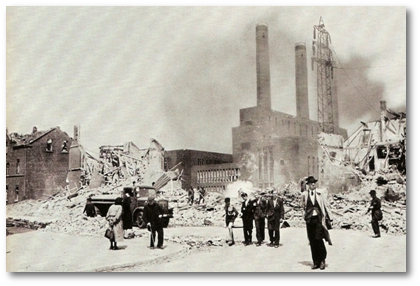 Fig. 4: cross-way Johannastraße/Koststraße in Gelsenkirchen-Horst, 1944. The house Koststraße No 13 (in the background) was destroyed in a bomb attack. Fig. 4: cross-way Johannastraße/Koststraße in Gelsenkirchen-Horst, 1944. The house Koststraße No 13 (in the background) was destroyed in a bomb attack.
The installation of the Stolperstein (stone of remembrance) in honour of Lothar Keiner will take place on Wednesday, 23rd May, 2018. Artist Gunter Demnig will place the stone in front of the last known address at free will in Gelsenkirchen-Horst, at the cross-way Koststrasse13/ corner Johannastraße (the original house Helenenstraße 13 does not exist any more due to massive bombdamage, names of streets have changed in the meantime).
This Stolperstein is the fourth in Gelsenkirchen in remembrance of a man who has been chased because of homosexual contacts in Nazi Germany. Stolpersteine have been installed for Arthur Herrmann and Ernst Papies (both Cranger Straße in GE-Buer) and Josef Wesener (Südstadt)
In addition to the above there are Stolpersteine for persecuted homosexuals in the following cities:
Bochum (10), Dortmund (1), Düsseldof (1), Duisburg (1), Essen (1), (Gelsenkirchen see above), Hattingen (1), Krefeld (1), Kreuztal-Kredenbach/district Siegen (1), Remscheid (3), Solingen (1), Trie (2), Velbert (1) and Wuppertal (2). More Stolpersteine will follow. Initiative, research and report concerning the life of Lothar Keiner and his death have been provided by Mr. Jürgen Wenke, certified psychologist, co-founder (1980) of the non-profit association Rosa Strippe e.V. and longtime head of the counselling centre for lesbians, homosexuals (gay men and women) and their families. Our sincere thanks go to Frau Terry Reintke, member of the European Parliament (Bündnis 90/Die Grünen in Gelsenkirchen) for taking the sponsorship for the Stolperstein. We also want to thank the dedicated coworkers of the Stolperstein initiative in Gelsenkirchen and all those, who supported the research regarding Lothar Keiner`s path of life. We are also very grateful to the staff of the „Sütterlinschreibstube“ in Hamburg where the letters written in Sütterlin bei Lothar Keiner (as was common in Germany at that time) were „translated“ into our handwriting, which was a great help.
Attachment
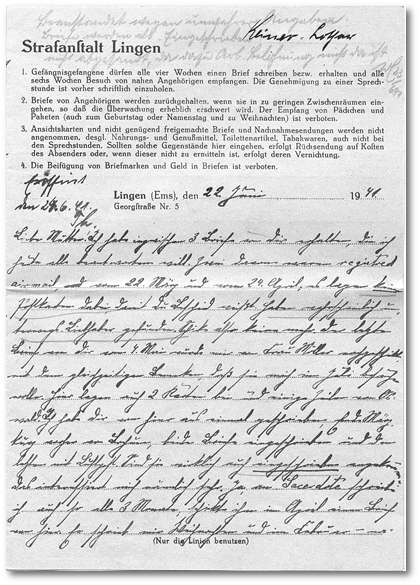 Fig. 5: Letter handwritten by Lothar Keiner in the prison of Lingen/Ems, addressed to his mother Mary Keiner (please click for magnification) Fig. 5: Letter handwritten by Lothar Keiner in the prison of Lingen/Ems, addressed to his mother Mary Keiner (please click for magnification)
There is no photo of Lothar Keiner. Whether mother and brother in the United States ever got to know about the death of the son/the brother, could never be clarified. It is also uncertain, if there are any descendants of brother Oswald living in the States.
Due to the censorship in Nazi Germany, there are numerous handwritten documents in the prison file of Lothar Keiner that outlived the regime. Two of them are letters to his mother Mary Keiner in New York and a letter to a close aquaintance of the family, Frau Lotte Möller in Dortmund, that was held back by the prison administration. These letters, „translated“ from Sütterlin in our today's handwriting are in attachment (PDF). The documentation „ Who was Lothar Keiner – in memoriam“ is available as PDF document for download and/or printout.
|
Recherche und Text: Diplom-Psychologe Jürgen Wenke
Quellen
Abb.1: Staatsarchiv Niedersachsen, Osnabrück, Rep947LinIINr15404_0052
Abb.2: Ebd., Rep947LinIINr15404_0003
Abb.3: Ebd., Rep947LinIINr15404_0076
Abb.4: Gelsenzentrum e.V.
Abb.5: Staatsarchiv Niedersachsen, Osnabrück, Rep947LinIINr15404_0054
|
